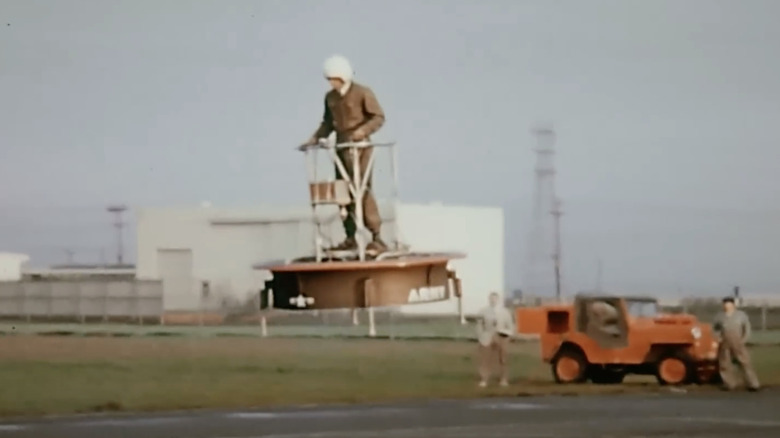The Rise And Fall Of The Military's Flying Platforms
What do the classic tale "The Arabian Knights," "Marvel's Silver Surfer," and the movie "Back to the Future II" all have in common? They each have someone who is flying around on some kind of platform. These included a magic carpet, a cosmic surfboard and a hoverboard, all being able to transport their riders in the air, over obstacles to arrive at a different destination. This was an intriguing concept that the U.S. military felt had potential for its soldiers and needed to be explored.
The U.S. was firmly entrenched in the throes of the Cold War with the Soviet Union by the 1950s. Military might and innovation measured who would get the upper hand in the struggle and the U.S. was open to radically different ideas to do so. During this time work was being conducted by the U.S. National Advisory Committee on Aeronautics (NACA, the forerunner to NASA) on the military potential of soldiers on flying platforms. This work took a step forward when one of their engineers, Charles H. Zimmerman proposed that a flying platform use vertical thrust via rotors and that the pilot would control it through kinesthetic responses. Now that the theory had been established, Zimmerman, NACA, and others set out to build working models, like the one shown above.
Flying soldiers?
Zimmerman's first attempt was "Flying Shoes." Essentially it was a single-pilot platform with small drone engines that were mounted vertically on the sides. The pilot controlled the vehicle by leaning his weight against a pole that was mounted to the craft. After not being able to solve its stability issues, the work was made available for others to try. As you can see in the above video, the Army experimented with a few options.
Three companies stepped up, including de Lackner, Bensen, and Hiller. The de Lackner company had the DH-4 Aerocycle in January 1955, which consisted of a pilot standing on top of large, exposed rotors with nothing to protect him should he fall into the rotors. Needless to say, it didn't take off. The Bensen design, the B-10 Propcopter, did not fare much better. Its construct consisted of a frame with front and rear-mounted 4-foot props that were powered by 72 HP engines. Like the others, it was difficult to control and after its 1959 flight, no further development was taken.
The Hiller company had some success. Its first version, the Model 1031, was completed in September 1954. It enjoyed greater stability, but its upward pitching motion restricted its speed to only 16 mph, which made it extremely difficult to control in strong winds. The Hiller team developed an enhanced version — the Model 1031-A-1. It took its first flight on Nov. 20, 1957, but its weight caused instability issues. After installing a gyro-stabilization system, a soldier could ride the platform, aim at a target and hit it. Unfortunately, it experienced oscillations in forward flight. A contract by the Army led to the bigger VZ-1E model in the late 1950s like the one, but it too suffered from control and stability.
What happened to the future?
As shown in the video above, flying platforms of the 1950s and 1960s showcased that it was possible to create flying soldiers. Engine-powered fan technology provided the mechanism for creating the lift for these platforms and served as the inspiration for Hiller and others in their creations to take the U.S. military into the future. Persistent stability and control issues however plagued the entire concept of flying platforms. These along with the military's need for more speed for its soldiers to perform reconnaissance and other missions, doomed the entire project by the late 1960s. The Army terminated the program in 1963.
All was not in vain however, as the work on flying platforms led to research and development of other equipment. Some of these would include flying jeeps like the 26-foot-long Piasecki Model 59H AirGeep, a jet-powered platform called the WR19, and the iconic UFO-shaped VZ-9-AV Avrocar. The quintessential jetpack had its time in the military's quest to create flying soldiers as well. It was abandoned by the military due to short flight times and the threat to pilot safety. Jetpacks are available today in various forms for civilian entertainment, however. The future that was imagined with soldiers soaring through the air has not happened due to the lack of sustained interest and development costs. Yet technology is always evolving which might yet give us our Buck Rogers.
